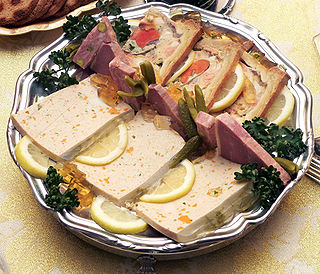
Espagnole sauce is a basic brown sauce, and is one of the mother sauces of classic French cooking. In the early 19th century the chef Antonin Carême included it in his list of the basic sauces of French cooking. In the early 20th century Auguste Escoffier named it as one of the five sauces at the core of France's cuisine.

Larousse Gastronomique is an encyclopedia of gastronomy first published by Éditions Larousse in Paris in 1938. The majority of the book is about French cuisine, and contains recipes for French dishes and cooking techniques. The first edition included few non-French dishes and ingredients; later editions include many more.

A mirepoix is a mixture of diced vegetables cooked with fat for a long time on low heat without coloring or browning. The ingredients are not sautéed or otherwise hard-cooked, because the intention is to sweeten rather than caramelize them. Mirepoix is a long-standing part of French cuisine and is the flavor base for a wide variety of dishes, including stocks, soups, stews, and sauces.

Quiche Lorraine is a savoury French tart with a filling of cream, eggs, and bacon or ham, in an open pastry case. It was little known outside the French region of Lorraine until the mid-20th century. As its popularity spread, nationally and internationally, the addition of cheese became commonplace, although it has been criticised as inauthentic. It may be served hot, warm or cold.

Cassoulet is a rich, slow-cooked stew originating in southern France. The food writer Elizabeth David described it as "that sumptuous amalgamation of haricot beans, sausage, pork, mutton and preserved goose, aromatically spiced with garlic and herbs". It originated in the town of Castelnaudary in the Aude department in the Occitanie region. Variants of the dish are local to other towns and cities in the Aude.

Blanquette de veau is a French veal stew. In the classic version of the dish the meat is simmered in a white stock and served in a sauce velouté enriched with cream and egg. It is among the most popular meat dishes in France.

Steak tartare or tartar steak is a French dish of raw ground (minced) beef. It is usually served with onions, capers, parsley or chive, salt, pepper, Worcestershire sauce, and other seasonings, often presented separately, to be added to taste. It is commonly served topped with a raw egg yolk. It is similar to the Levantine kibbeh nayyeh, the Turkish çiğ köfte, the German Mett and the Korean yukhoe.

Pâté is a forcemeat. Originally, the dish was cooked in a pastry case; in more recent times it is more usually cooked without pastry in a terrine. Various ingredients are used, which may include meat from pork, poultry, fish or beef; fat, vegetables, herbs, spices, wine and brandy.

Daube is a French slow-cooked stew, usually of beef, but other meat is sometimes used. The best-known is the bœuf en daube à la provençale, a Provençal stew made with cheaper cuts of beef braised in wine, with vegetables, garlic and herbs, and traditionally cooked in a daubière–a braising pot.

Mise en place is a French culinary phrase which means "putting in place" or "gather". It refers to the setup required before cooking, and is often used in professional kitchens to refer to organizing and arranging the ingredients that a cook will require for the menu items that are expected to be prepared during a shift.
An alicot, otherwise known as an alicuit or ragout d'abattis is a southern French stew made of the cheapest parts of poultry, slowly simmered.

Confit is any type of food that is cooked slowly over a long period as a method of preservation.

Pot-au-feu is a French dish of slowly boiled meat and vegetables, usually served as two courses: first the broth (bouillon) and then the meat (bouilli) and vegetables. The dish is familiar throughout France and has many regional variations. The best-known have beef as the main meat, but pork, chicken, and sausage are also used.

Charcuterie is a branch of French cuisine devoted to prepared meat products, such as bacon, ham, sausage, terrines, galantines, ballotines, pâtés, and confit, primarily from pork.

Gratin is a culinary technique in which a dish is topped with a browned crust, often using breadcrumbs, grated cheese, egg or butter. The term may be applied to any dish made using this method. Gratin is usually prepared in a shallow dish of some kind. A gratin is baked or cooked under an overhead grill or broiler to form a golden crust on top and is often served in its baking dish.

Navarin is a French ragoût (stew) of lamb or mutton. If made with lamb and vegetables available fresh in the spring, it is called navarin printanier. The dish was familiar in French cookery well before it acquired the name "navarin" in the mid-19th century; there are several theories about the origin of the current name.

Flamiche is a French savoury pastry, originating in the north-west France. It dates to medieval times and originally was a kind of galette, but in its modern version is a tart made with leeks and cream.
In cooking, a matignon is a mirepoix in which the ingredients are minced rather than diced, and more flavorings added. Matignon, unlike mirepoix, is not a part of the food preparation itself, but is always served at the table.

A matelote is the name given in French cooking to a fish stew made with white or red wine. It is normally made with freshwater fish, and may contain a mixture of different fish or a single species. It is traditionally garnished with small onions and mushrooms that have been cooked with the fish.

















